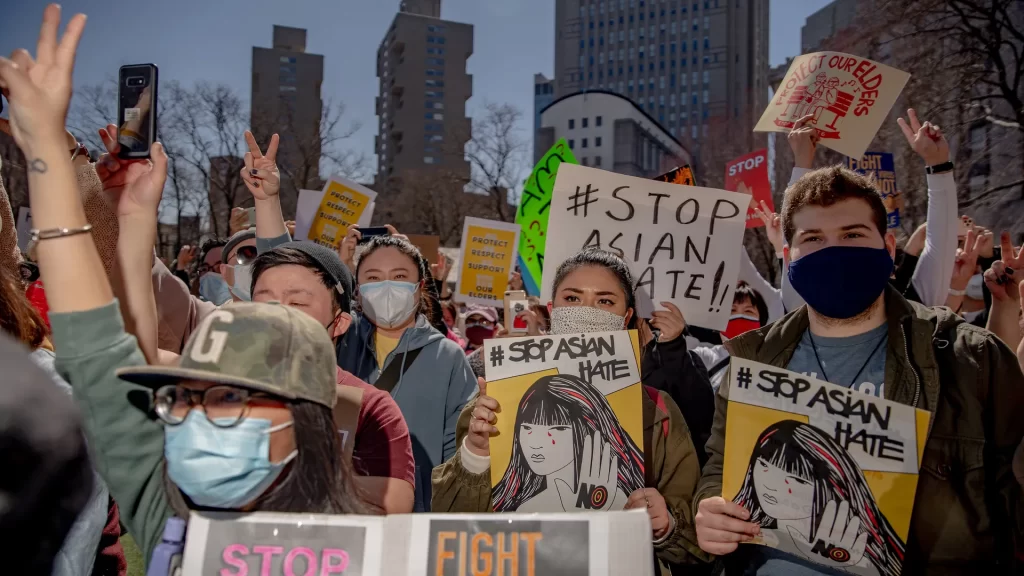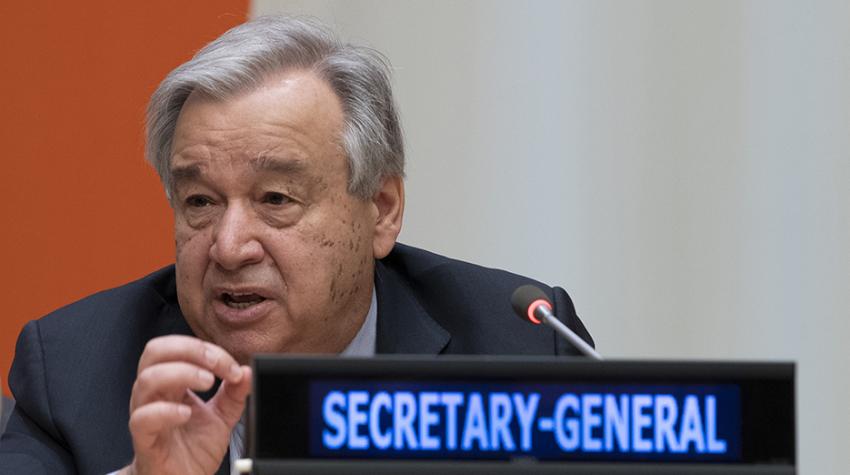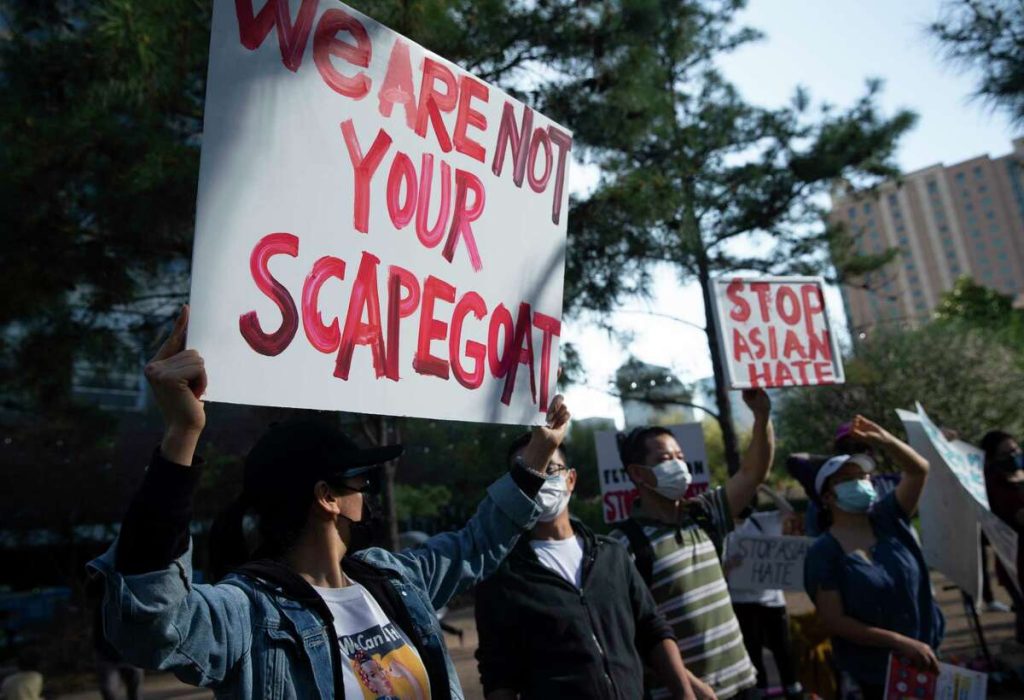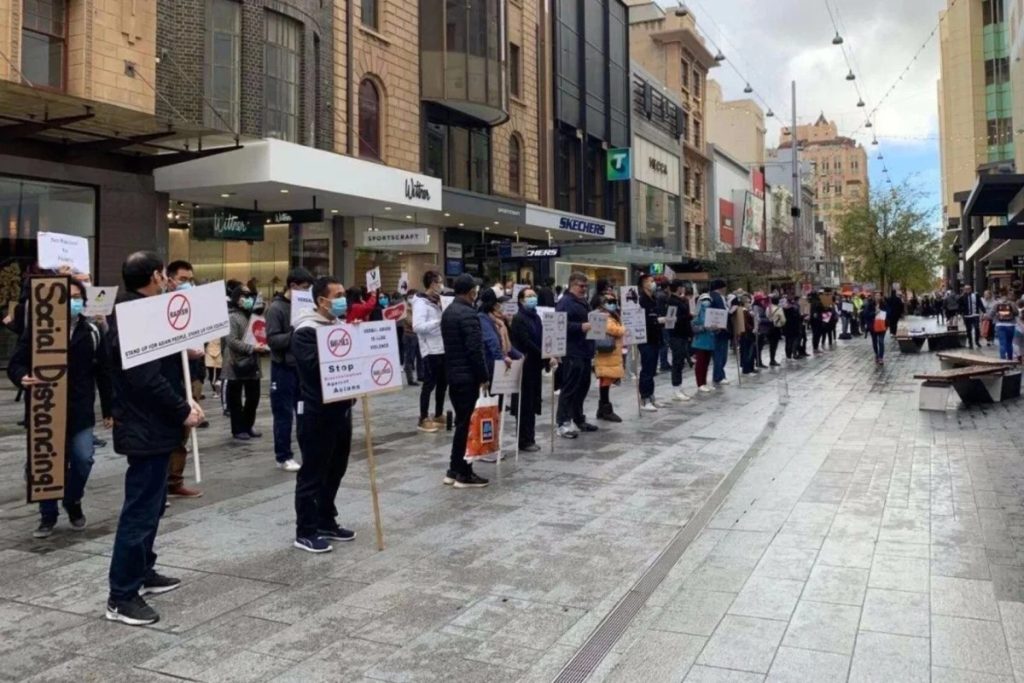
Figure 1: “Protesters in New York City rallying against anti-Asian hate during the COVID-19 pandemic. Demonstrators hold #StopAsianHate signs to show solidarity with Asian American communities.
Introduction
When COVID-19 first emerged, it brought not only a deadly virus but also an alarming surge in xenophobia. In early 2020, as fear and uncertainty spread, so did hateful rhetoric targeting people of Chinese and Asian descent around the world. Chinese restaurants were shunned in New York; “#ChineseDon’tComeToJapan” trended on Twitter; a stranger in London shoved a Chinese family down a subway staircase while shouting “you are a virus.”Such incidents, once isolated, quickly became a global pattern. United Nations Secretary-General António Guterres warned of a “tsunami of hate and xenophobia, scapegoating and scaremongering” unleashed by the pandemic. Indeed, COVID-19 fueled a pandemic of hate: a wave of anti-Chinese and anti-Asian speech that spread online and off, with devastating real-world consequences.

Figure 2: “Protesters in New York City rallying against anti-Asian hate during the COVID-19 pandemic. Demonstrators hold #StopAsianHate signs to show solidarity with Asian American communities.
This blog post explores how the coronavirus crisis ignited an explosion of anti-Chinese hate speech across different countries, why this rhetoric took hold, and what it tells us about the interplay of online harms and offline consequences. We will look at what hate speech is, how it flourished during COVID-19, and examine case studies from the United States and Australia. Along the way, we’ll consider how social media amplified the hate, how communities fought back (think #StopAsianHate rallies and YouTube testimonies), and what can be done to counter this “other” pandemic. Let’s dive in – in plain language – to understand the serious spread of online hate that accompanied COVID-19, and why it matters to all of us in the digital age.
What Is Hate Speech, and Why Does It Matter?
Hate speech is more than just offensive language. It targets people based on race, ethnicity, religion, gender, or other attributes, often aiming to incite harm or discrimination. It’s different from unpopular opinions; it attacks vulnerable groups and can trigger real-world violence.
As Mondal et al. (2017) found, nearly 90% of abusive posts on Twitter target race or ethnicity. History shows hate speech can fuel serious harms, from genocide to everyday violence.
Hate speech often happens in public spaces, targets marginalized groups, and is spread by people with influence. COVID-19 gave us a clear example of this.
The Other Pandemic: COVID-19 and a Wave of Anti-Asian Hate
Pandemics often breed scapegoating. During COVID-19, with the virus first identified in China, anti-Chinese sentiment surged. By February 2020, over 1,000 incidents of anti-Asian harassment had been reported in the U.S. Similar incidents happened in Italy, Spain, France, and Australia.
Part of this came from fear and ignorance. But leadership and media rhetoric also played a role. Some politicians used terms like “Chinese virus,” sending a signal about who to blame. Human Rights Watch found officials in the U.S., UK, and elsewhere encouraged hate by stoking conspiracy theories.
Social media amplified the problem. Slurs like “Kung Flu” and “Wuhan virus” spread widely, mixed with misinformation about Chinese eating habits or government coverups. This normalized hate speech. As one study noted, “biased people justify and defend their hate speech using misinformation.”
Before long, real-world violence followed. Chinese students in the UK reported fearing racism more than the virus. A Singaporean student in London was hospitalized after a brutal hate crime. COVID-19 didn’t care about race — but racism turned Asians into targets.
Let’s look closer at two key case studies.
Case Study: United States – From “Chinese Virus” to #StopAsianHate

Figure 3: “Protesters at a rally in Houston, Texas (March 2021), holding signs such as “We Are Not Your Scapegoat” and “Stop Asian Hate,” expressing solidarity against anti-Asian discrimination”.
In the United States, the COVID-19 hate wave was especially strong. Former President Donald Trump repeatedly called COVID-19 the “Chinese Virus” in March 2020 and joked about “Kung Flu” later that year.
Research by Kim and Kesari (2021) showed an immediate spike in anti-Asian hashtags and hate speech after Trump’s tweet. Counter-speech defending Asians also increased, but the damage was done. Misinformation, like claims that China “weaponized” the virus, spread alongside the hate.
Offline, Asian Americans experienced a sharp rise in harassment and attacks. Stop AAPI Hate recorded over 9,000 anti-Asian incidents in one year, with about 64% involving verbal abuse. Children were among those targeted — one Chinese American middle-schooler was told to “f** off the planet with viruses.”
Hate crimes against Asians surged by nearly 150% in major U.S. cities in 2020. Elderly Asian Americans were often attacked. In one case, an 84-year-old Thai man in San Francisco was shoved to death. In another, a man was slashed across the face in New York.

Figure 4: “Data visualization showing the sharp rise in anti-Asian hate crimes across major U.S. cities from 2019 to 2020. New York, Los Angeles, and San Francisco saw especially large increases”.
The politicization of the virus played a big role. Conservative media repeated terms like “Wuhan virus” — with one study finding an 800% rise in their use by early March 2020 (Yam, 2020). Online extremists fueled the narrative that Chinese people were a threat.
As scholar Bhikhu Parekh (2012) notes, hate speech often paints its targets as a menace. In 2020, Asians were scapegoated as public health threats.
But there was also a strong pushback. By early 2021, the hashtag #StopAsianHate trended worldwide. Vigils and protests, especially after the Atlanta spa shootings, brought attention to the issue. Public figures condemned the violence. Congress passed the COVID-19 Hate Crimes Act in April 2021 to better track and prosecute anti-Asian hate.
Case Study: Australia – Sinophobia Down Under

Figure 5: “In April 2020, a community-run COVID-19 racism incident survey recorded 178 incidents in just two weeks against Asians in Australia.”
Across the Pacific in Australia, a multicultural country with a large Chinese-Australian population, the pandemic also unleashed a wave of anti-Asian hate – though on a smaller scale than in the U.S. Early on, there were striking parallels. In April 2020, a community-run COVID-19 racism incident survey recorded 178 incidents in just two weeks (about 12 per day) against Asians in Australia. By mid-year, the total had risen to 377 incidents in two months, roughly 47 per week. These weren’t just harmless comments online; many were face-to-face harassment and assaults. In one incident from Perth, a 23-year-old woman reported a group of men told her “Go eat bats and die alone. Don’t come to Australia.”She was then physically threatened and spat on. Another report described a teenage girl in Brisbane punching a woman in the face while accusing her of carrying COVID. The common thread was clear: Australians of Asian appearance were being vilified as spreaders of the virus, echoing the same ugly trope seen elsewhere.
It’s worth noting that Australia, like many Western countries, saw racist narratives amplified by a few fringe political figures and media personalities. For example, a former senator infamously claimed in a TV interview that Chinese people were “unclean” and to blame for the virus due to their eating habits (a comment widely condemned as racist nonsense). Such statements, even if coming from the political fringe, received media coverage and social media attention, reinforcing stereotypes. Meanwhile, far-right groups in Australia latched onto pandemic fears to advance anti-Chinese agendas. They circulated memes and conspiracy theories accusing Chinese-Australians of disloyalty or malign intentions (e.g. hoarding supplies or being agents of the Chinese Communist Party). This created an atmosphere of mistrust toward anyone who looked East Asian.
On the ground, many Chinese-Australians felt the impact in their daily lives. Anecdotally, Asian grocery stores and restaurants saw drops in customers. International students from China (a significant cohort in Australian universities) faced ostracism; some who had returned to China for the Lunar New Year found themselves targets of nasty comments when they came back as the pandemic unfolded. In Sydney and Melbourne, students told researchers they were suddenly yelled at with slurs like “Corona!” or told to “go home” when walking in public (Asian Australian Alliance, 2020 report). Community leaders described this as a resurgence of “Sinophobia” – a fear or dislike of China and its people – that they hadn’t seen in decades.
However, Australia also responded with some community resilience. Asian Australians began sharing their stories on social media and with news outlets, shining a light on the abuse. The hashtag #IAmNotAVirus trended in Australia as people objected to being collectively blamed. Human rights organizations and activists pushed back, and by mid-2020 even government officials (and police) were publicly urging tolerance. The Queensland Police Commissioner, for instance, went on record to encourage victims of racism to come forward and promised that hate-motivated offenses would be taken seriously. This official recognition was important in a country that, unlike the U.S., doesn’t have specific federal “hate crime” laws – racist incidents are usually prosecuted under general assault or vandalism laws.
One positive outcome was increased dialogue about racism in Australia. Major news outlets ran stories about Asian Australians’ experiences of pandemic racism, and surveys indicated many more Australians became aware of the issue. According to one national poll, over 80% of Asian Australians reported feeling discriminated against during COVID-19 (ABC News, 2021) – a sobering statistic that sparked conversations about the nation’s self-image as a successful multicultural society. In that sense, the COVID-19 hate wave forced Australia to confront some uncomfortable truths and hopefully prepare better for combating racism in the future.
Fighting the Virus of Hate: What Can Be Done?
The COVID-19 pandemic showed how quickly dangerous speech can spread online and cause real-world harm. To tackle this “virus of hate,” social media platforms, governments, and individuals all have a role to play.
1. Responsible Leadership and Rhetoric
Words from leaders matter. Public figures should avoid scapegoating and instead focus on the virus itself. As UN Secretary-General Guterres urged, leaders must “strengthen the immunity of our societies against the virus of hate” (Human Rights Watch, 2020). Health experts helped by emphasizing that no ethnicity is more likely to carry COVID-19, and terms like “Wuhan Virus” are misleading. Empathetic, science-based messaging can help prevent the normalization of hate.
2. Counter-Speech and Community Support
Civil society plays a critical role in resisting hate. During the pandemic, counter-speech movements like #StopAsianHate emerged, offering solidarity to victims and challenging racist narratives. Marches, rallies, and educational campaigns helped counter misinformation and emphasized unity. Digital literacy efforts also reduced the spread of false claims, encouraging people to critically evaluate what they see online.
3. Platform Accountability
Social media companies must take more responsibility. As Sinpeng et al. (2021) note, platforms like Facebook and Twitter updated their hate speech policies during the pandemic. Twitter pledged to remove tweets inciting harm, while Facebook deleted millions of posts using slurs like “Chinese virus” harmfully. Yet critics argue these efforts were slow and inconsistent. Automated moderation often struggles with nuance, making investment in culturally aware human moderators crucial, especially for non-English languages.
4. Legal and Policy Measures
Strong laws help deter hate crimes. In the U.S., the COVID-19 Hate Crimes Act was passed to improve reporting and tracking of anti-Asian incidents. Australia used existing laws to prosecute hate-related assaults, but calls grew for stronger anti-vilification statutes. International organizations like the UN have urged all governments to create action plans against racism, combining legal enforcement with education.
5. Empathy and Solidarity
Empathy is key to healing divisions. The pandemic should have united humanity against a common enemy, but racism often prevailed. Moving forward, rebuilding solidarity is vital. Acts like escorting vulnerable Asian elders or standing up against harassment help create a cultural norm that hate is unacceptable. Online, counter-speech—responding calmly and accurately to hateful comments—can reduce their impact.
Conclusion
COVID-19 revealed that hate spreads like a virus—mutating into slurs, memes, and violence. But it also showed that hate can be challenged. Combating it requires better leadership, stronger laws, smarter platform policies, and most importantly, community solidarity.
If we stay vigilant about language, educate ourselves and others, and show up for those targeted, we can build a world where unity spreads faster than hate.
References
Agwuocha, U. A. (2021). COVID-19 induced hate speech and Austin’s speech act theory perspective: Implications for peace building. In Proceedings of the International Conference of the Association for the Promotion of African Studies on African Ideologies, Human Security and Peace Building, 10–11 June 2020 (pp. 159–182).
Braun, S. (2021, August 12). Statement: New data shows that Asian Americans remain under attack — Over 9,000 Anti-Asian incidents reported. Stop AAPI Hate.
Cabral, S. (2021, May 21). Covid “hate crimes” against Asian Americans on rise. BBC News.
Flew, T. (2021). Regulating Platforms. Polity Press.
Human Rights Watch. (2020, May 12). Covid-19 Fueling Anti-Asian Racism and Xenophobia Worldwide.
Kim, J. Y., & Kesari, A. (2021). Misinformation and hate speech: The case of anti-Asian hate speech during the COVID-19 pandemic. Journal of Online Trust and Safety, 1(1), 1–14.
Mondal, M., Silva, L. A., & Benevenuto, F. (2017). A measurement study of hate speech in social media. In Proceedings of the 28th ACM Conference on Hypertext and Social Media (HT 2017) (pp. 85–94). ACM.
Parekh, B. (2012). Is there a case for banning hate speech? In M. Herz & P. Molnar (Eds.), The Content and Context of Hate Speech: Rethinking Regulation and Responses (pp. 37–56). Cambridge University Press.
Sinpeng, A., Martin, F. R., Gelber, K., & Shields, K. (2021). Facebook: Regulating hate speech in the Asia Pacific. Sydney: University of Sydney & University of Queensland.
Yam, K. (2020, September 30). Anti-Asian bias rose after media, officials used “China virus,” report shows. NBC News.
Yam, K. (2021, March 10). Anti-Asian hate crimes increased by nearly 150% in 2020, mostly in N.Y. and L.A., new report says. NBC News.
Zhou, N. (2020, April 17). Survey of Covid-19 racism against Asian Australians records 178 incidents in two weeks. The Guardian.
Zhou, N. (2020, July 24). Asian Australians threatened and spat on in racist incidents amid coronavirus. The Guardian. BBC News. (2021, March 20). Atlanta shootings: ‘It’s scary just to be an Asian American woman’ – BBC News

Be the first to comment